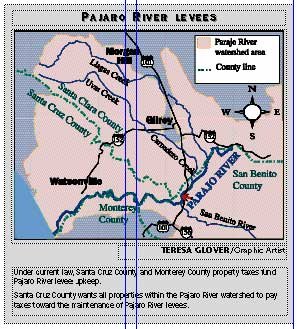GILROY
– Santa Clara County continued its fight last week against a
proposal to make its residents, including Gilroyans, help pay for
river levee maintenance in neighboring Santa Cruz County.
GILROY – Santa Clara County continued its fight last week against a proposal to make its residents, including Gilroyans, help pay for river levee maintenance in neighboring Santa Cruz County.
Santa Clara County Supervisors unanimously approved a “letter of concern” outlining four reasons why the unprecedented taxing system should not be allowed by the state. In the letter, Santa Clara County Supervisors call their neighboring county’s tax plan a “grossly expanded assessment district” and claim Santa Cruz County is trying to transfer its obligation for Pajaro River levee upkeep to the state during these tight budget times.
The letter is being sent to the state Department of Water Resources and state legislators representing the South Valley and Coastal counties. It could be followed by other similar letters next month after Santa Clara County District 1 Supervisor Don Gage meets with Gilroy, Morgan Hill and representatives of other communities in the 1,310-square-mile Pajaro River watershed.
The concern is this: Santa Cruz County wants the state to tax property owners within all four counties – Santa Clara, San Benito, Santa Cruz and Monterey – of the Pajaro River watershed for river levee upkeep.
If the proposal gets approved by the state, large portions of Santa Clara and San Benito counties will see a new charge on their tax rolls. Currently, only Monterey and Santa Cruz counties pay for Pajaro River levee maintenance.
“I’m going to ask everyone in the Pajaro River watershed to write letters like the one the county did because this is a ridiculous plan,” Gage said.
The four reasons why residents of Santa Clara and San Benito counties should not be subject to the “levee levy” are as follows:
• Taxing one county for a levee system in another county may violate state water code and the California Constitution.
• Upstream properties are not subject to flooding from the Pajaro River and therefore would derive no benefit from paying for the operation and maintenance of the levees.
• A court has previously ruled that upstream jurisdictions are not responsible for operation and maintenance of downstream levees.
• Runoff from upstream Santa Clara County properties has been mitigated by its reservoir system which is not supported with taxes from downstream jurisdictions.
“We want to be good neighbors, but we’re not causing the problem. If we were causing the problem, then I’d be all for doing our part,” Gage said.
The problem is that the volatile Pajaro River can overflow and cause flooding that destroys fields and homes – exactly what happened in 1995, resulting in a lawsuit against Caltrans, Santa Cruz and Monterey counties. The defendants lost.
Caltrans was a defendant because it paved a percentage of the roads in the quad-county area that contributed to excess runoff. Because paved roads cannot absorb rainfall like the natural ground, the region has less groundwater and more runoff than if it were undeveloped. More runoff leads to higher river levels which sometimes break or flow over natural and manmade levees.
Since the lawsuit, officials have been scrambling to make sure the overflow doesn’t happen again.
Santa Cruz and Monterey are now working on a program for improving and rebuilding the existing system of river levees along the Pajaro. Santa Cruz County doesn’t want its property owners to be taxed for that effort since a $2 million state study says development in communities upstream from the Pajaro, such as Gilroy, do not contribute to the overflow of the river.
Meanwhile, Santa Cruz officials are not convinced. They point to studies of their own revealing that the severity of Pajaro floods has increased because of development upstream. They also claim that if all four counties which impact Pajaro River levels pay for the levee maintenance, the cost would be insignificant.
For 2003-04, $350,000 is budgeted for levee maintenance. Currently, that cost is split by nearly 15,000 property owners.
“We’re not talking about that much money per parcel based on these numbers,” said Stephanie Camacho, an analyst for Santa Cruz County Supervisor Ellen Pirie.
But Gage worries these numbers are just a portion of what his constituents may be taxed for in the future.
Beyond yearly maintenance there is levee construction and that 1995 lawsuit that remains unpaid. Estimates of damages range from $50 million to $100 million.
“Who’s going to pay for all that?” Gage asked.
The downstream counties of Santa Cruz and Monterey also worry the Pajaro River will overflow more often now that a court decided Gilroy and Morgan Hill have the right to send tertiary water – used water that has been cleaned – from Uvas and Llagas creeks into the Pajaro.
None of Gilroy and Morgan Hill’s tertiary water gets sent to the Pajaro River now, but in future rainy seasons it may be necessary to keep Uvas and Llagas creeks from overflowing, says Gilroy City Councilman Bob Dillon, a representative on the South County Regional Wastewater Authority.
“Any discharge would be 2 percent of the flow and it would be cleaner than the water that’s already in the Pajaro River,” Dillon said. “I think it’s legally dubious (Santa Cruz County) wants to make us pay for the upkeep of their levees.”












